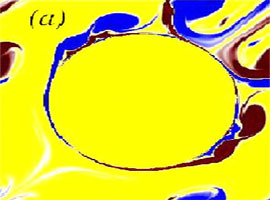| |
 Many partial differential equations have solutions that are localized
in both position and time. For example, turbulence is characterized
by highly intermittent and non-stationary vorticity fields. In
addition, high Reynolds number turbulence has motions over a very
large range of length scales and thus requires a very fine
computational grid and small time step. Other examples incluse
combustion, chemical reactions, fluid-structure interaction, and shock
propagation. Because of the fine resolution required, conventional
techniques are not efficient for these problems. We require a method
where the computational grid automatically adapts match the solution.
In other words, we want to put the grid points only where they are
needed.
Many partial differential equations have solutions that are localized
in both position and time. For example, turbulence is characterized
by highly intermittent and non-stationary vorticity fields. In
addition, high Reynolds number turbulence has motions over a very
large range of length scales and thus requires a very fine
computational grid and small time step. Other examples incluse
combustion, chemical reactions, fluid-structure interaction, and shock
propagation. Because of the fine resolution required, conventional
techniques are not efficient for these problems. We require a method
where the computational grid automatically adapts match the solution.
In other words, we want to put the grid points only where they are
needed.
Our adaptive wavelet method is based on tensor products of second
generation wavelets constructed on a hierarchy of nested dyadic grids.
Because we use collocation wavelets, each wavelet (at a given position
and scale) corresponds to a particular grid point. Therefore, by
transforming the solution to wavelet space and then removing wavelets
with coefficients smaller than a given threshold we automatically
adapt the grid to the solution.
We have been using adaptive wavelet filtering for the following problems:
1. Numerical solution of time evolution problems. To allow for the
change in the solution over a time step, we add nearest neighbour grid
points in position and scale. The nearest neighbours in position allow
for advection, and the nearest neighbours in scale avoid aliasing
errors. We have applied this method to solve turbulence modelling and
fluid-structure interaction problems.
2. Simultaneous space-time method. In this case we solve a time
evolution problem on a space-time domain. This allows us to adapt
both the spatial resolution and time step to local intermittency. We
are applying this method to the Burgers equation and the
Kuramoto-Sivashinsky equation in one space dimension, and intend to
apply it to 2D and 3D turbulence problems.
3. Signal analysis. We have used the de-noising properties of
wavelet filtering to extract the coherent structures (i.e. vortices)
from turbulent flows. This method can also be used as the filter in a
LES-like turbulence model.
4. Solution of elliptic partial differential equations. We have developed
an adaptive wavelet version of the multilevel method for linear and
nonlinear partial differential equations.
|
|